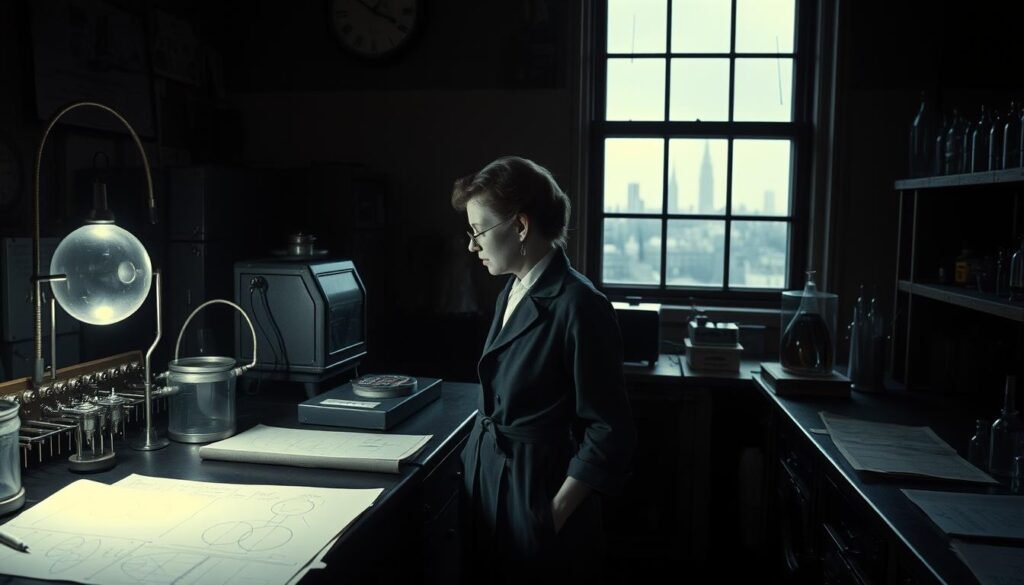The periodic table element 109 bears her name today, but in 1906, she entered the prestigious physics institute in Berlin through the back door—literally—as women were officially prohibited from the premises where she would eventually make discoveries that revolutionized atomic research and challenged the very foundations of physics.
As a female physicist, she encountered numerous hurdles. Yet, her unwavering determination and sharp intellect opened doors to groundbreaking scientific discoveries. Her role in unraveling the puzzle of nuclear fission solidified her status as one of the leading nuclear physics pioneers of her time.
Through the decades, her remarkable path has underscored the critical role of determination, serving as a wellspring of motivation for researchers even now.
The Forgotten Pioneer of Physics
Lise Meitner, a woman in a male-dominated field, faced numerous challenges. Yet, her work in physics remains unmatched. Meitner’s scientific contributions were groundbreaking despite the obstacles she was forced to overcome.
A Brilliant Mind in a Male-Dominated Field
Meitner’s journey in physics was marked by her exceptional talent and determination. She encountered scientific discrimination and was often overlooked for her work. This was a common plight for forgotten women scientists. Despite these challenges, Meitner persevered, continuing to make significant contributions to the field.
The Significance of Meitner’s Contributions
Meitner’s work on nuclear fission was a critical breakthrough in modern physics. Her contributions, in collaboration with Otto Hahn, laid the foundation for significant advancements in the field.
Impact on Modern Physics
The discovery of nuclear fission by Meitner and Hahn had a profound impact on modern physics. It paved the way for further research into nuclear reactions and their applications.
Historical Context of Her Work
Meitner’s work was conducted against the backdrop of rising anti-Semitism in Nazi Germany. This added a layer of complexity to her story. The Nobel Prize controversy surrounding her contributions, in comparison to Hahn’s solo award in 1944, highlights the scientific discrimination she faced.
Meitner’s legacy as a pioneering woman in physics continues to inspire new generations of scientists. Her story serves as a reminder of the importance of recognizing the contributions of all scientists, regardless of gender.
Early Life and Education: Breaking Barriers
In 1878, Vienna welcomed Lise Meitner, a child destined to challenge the male-dominated physics field. Her early years were marked by a supportive family environment that fostered her educational pursuits.
Childhood in Vienna (1878-1901)
Meitner was born into a middle-class Jewish family, the third of eight children. Her family’s background significantly influenced her early interests.
Family Background and Influences
Meitner’s parents supported her educational endeavors, a progressive stance for the time. This support was critical in nurturing her curiosity and interest in learning.
Early Interest in Science
Meitner’s fascination with science began early. She was drawn to mathematics and physics, subjects uncommon for women in her era.
Pursuing Higher Education Against the Odds
Despite societal barriers, Meitner was determined to pursue her academic interests. She faced numerous challenges, including academic gender bias, but persevered.
Meitner’s journey was not without obstacles. Women were often barred from formal academic programs, compelling her to seek alternative paths to higher education.
Mentorship Under Ludwig Boltzmann
A significant turning point in Meitner’s academic career was her mentorship under Ludwig Boltzmann. His guidance deepened her understanding of physics and instilled a passion for scientific inquiry.
Under Boltzmann’s mentorship, Meitner’s talent flourished, setting the stage for her future contributions to physics. Her experiences during this period were instrumental in shaping her career as an Austrian physicist.

Meitner’s story is a testament to the impact of women who changed science. Her perseverance in the face of adversity and groundbreaking work inspire scientists globally.
Berlin Years: Rise in Nuclear Research
In the vibrant scientific landscape of early 20th-century Berlin, Lise Meitner forged a critical partnership with Otto Hahn. This collaboration significantly impacted the field of nuclear physics.
Partnership with Otto Hahn
Meitner’s collaboration with Hahn started in 1907 and was foundational to her research career. Their partnership was built on a complementary division of labor.
Formation of the Research Team
Together, Meitner and Hahn formed a research team that became a cornerstone of the Berlin physics community. Their team was known for its rigorous approach to scientific inquiry.
Division of Responsibilities
Meitner focused on the physics aspects of their research, while Hahn concentrated on the chemistry. This division of responsibilities allowed them to cover a broader range of topics in nuclear physics.
Establishing a Research Program
Their research program was ambitious, aiming to explore the mysteries of radioactivity. Meitner’s contributions were instrumental in shaping their research direction.

World War I and Its Impact on Research
The onset of World War I created substantial barriers to their scientific pursuits. However, Meitner and Hahn persisted in their research, propelled by their passion for discovery and determination to expand upon Meitner’s pioneering contributions to the field.
Their perseverance during this period laid the groundwork for future breakthroughs. Even as the Otto Hahn controversy would later surround their collaborative work, their dedication remained unwavering.
Lise Meitner: The Mother of Nuclear Fission
Lise Meitner’s discovery of nuclear fission revolutionized physics. Her contributions were not just groundbreaking but also laid the groundwork for major advancements in nuclear physics.
The Groundbreaking Experiments
Meitner’s work on nuclear fission was a collaboration with Otto Hahn. Together, they bombarded uranium with neutrons to study the reactions that followed.
Methodology and Approach
Meitner and Hahn’s methodology was meticulous. They combined chemical and physical methods to analyze their findings.
As Meitner noted,
“The experiments were designed to test the hypothesis that the uranium nucleus could be split.”
This meticulous approach led to the groundbreaking discovery of nuclear fission.
Technical Challenges Overcome
Meitner and her team faced significant technical hurdles. They had to detect and measure the products of nuclear reactions. They overcame these challenges through innovative designs and rigorous testing.
The Critical Insight: Understanding Atomic Splitting
Meitner and Otto Frisch’s interpretation of their results was a turning point. They understood that uranium nuclei were splitting, releasing a lot of energy.
The discovery of nuclear fission was a turning point in physics history. It deepened our understanding of atomic nuclei and had significant implications for energy and nuclear weapons.
Publishing the Discovery with Otto Frisch
Meitner and Frisch published their findings on nuclear fission. They explained the process and its implications in detail. This publication was a major milestone in nuclear physics, opening doors for further research.
Their work was directly linked to the development of the atomic bomb and the Manhattan Project. It provided essential insights into nuclear fission.
Escape from Nazi Germany: Science in Exile
The Nazi regime’s persecution of Jews forced Lise Meitner to make a difficult decision about her future in Germany. As the political climate worsened, Meitner, a prominent figure in nuclear research, found herself in an increasingly untenable position.
Rising Anti-Semitism and Persecution
Meitner’s Jewish background made her a target for persecution under the Nazi regime. The rise of anti-Semitism had a direct impact on her career, leading to significant personal and professional challenges.
Loss of Academic Position
Meitner lost her academic position due to the Nazi’s Law for the Restoration of the Professional Civil Service, which directly targeted Jews and other perceived enemies of the state. This loss marked the beginning of a period of increasing hardship for Meitner.
Increasing Personal Danger
As the Nazi regime’s policies became more aggressive, Meitner faced increasing personal danger. Her situation in Germany became untenable, prompting her to consider escape as the only viable option.
The Dramatic Flight to Sweden
In 1938, Meitner made a dramatic escape to Sweden, facilitated by her connections with other scientists. This flight was not without its challenges, as Meitner had to leave behind her career and many of her possessions.

Continuing Work from Abroad
Despite the challenges she faced, Meitner continued her scientific work from abroad. She maintained her research and collaborations, contributing significantly to the field of nuclear physics even in exile.
Meitner’s experience as a sciene refugee highlights the broader exodus of scientist from Nazi Germany. Many talented scientists were forced to flee, leading to a significant loss of talent for Germany but a gain for the global scientific community.
The Nobel Prize Controversy: Recognition Denied
The oversight of Lise Meitner’s role in the 1944 discovery of nuclear fission is a significant injustice in Nobel Prize history. It highlights gender bias in science and the complexities of recognition during geopolitical turmoil. This event is a stark reminder of the challenges women faced in the scientific community.
Otto Hahn’s Solo Nobel Prize in 1944
In 1944, the Nobel Prize in Chemistry was awarded to Otto Hahn alone for nuclear fission work. This decision ignored Meitner’s essential contributions, sparking widespread criticism. Ruth Sime, a biographer of Meitner, noted that Meitner’s exclusion from the Nobel Prize was a grave injustice.
“The exclusion of Meitner from the Nobel Prize was a grave injustice, given her pioneering work on nuclear fission.” – Ruth Sime
The Politics Behind the Decision
The Nobel Prize decision to honor Hahn without Meitner was influenced by gender bias and wartime politics. These factors played a significant role in the oversight of Meitner’s contributions.
Gender Bias in Scientific Recognition
Gender bias was a major factor in Meitner’s exclusion. As a woman in a male-dominated field, she faced numerous challenges. The Nobel Committee’s decision reflected broader societal biases against women in science.
Wartime Complications
World War II added to the complexities of the Nobel Prize decision. Meitner, fleeing Nazi Germany, was in exile in Sweden by the time the prize was awarded. Her refugee status and the political tensions of the time further complicated her chances.
Historical Reassessment of the Injustice
Years after the controversy, there has been a significant historical reassessment of Meitner’s contributions. Many now recognize the injustice done to her, acknowledging her critical role in discpvery of nuclear fission. This reassessment has cemented Meitner’s place in the history of science, ensuring her contributions are widely recognized.
The story of Lise Meitner and the Nobel Prize controversy highlights the challenges women faced in science. It emphasizes the importance of acknowledging all individuals’ contributions to scientific progress.
Later Life and Scientific Contributions
Meitner’s later years were marked by her unwavering dedication to scientific discovery and her ethical concerns. Despite the obstacles she encountered, she continued to make significant contributions to science.
Work in Sweden and the United Kingdom
Escaping Nazi Germany, Meitner found a new home in Sweden, where she continued her research. She then moved to the United Kingdom, expanding her scientific pursuits. Her work during this time was characterized by an unrelenting passion for nuclear physics.
Stance on Nuclear Weapons and the Manhattan Project
Meitner openly opposed the development and use of nuclear weapons. Her experience with nuclear fission and its application in World War II profoundly shaped her views on the Manhattan Project.
Ethical Considerations
Meitner struggled with the ethical implications of her discovery, aware of the catastrophic consequences of nuclear weapons. She advocated for the ethical application of scientific knowledge, stressing the importance of responsible research.
Correspondence with Einstein and Bohr
Meitner exchanged ideas with renowned scientists like Einstein and Bohr, discussing the ethics of nuclear physics. These conversations underscored her ongoing commitment to the scientific community and her concerns about nuclear research’s trajectory.
Final Years and Death in Cambridge (1968)
Meitner’s final years were spent in Cambridge, where she remained active in scientific discussions. She passed away in 1968, leaving behind a legacy of pioneering work in nuclear physics and a strong advocacy for ethical science.
Meitner’s impact goes beyond her scientific achievements. She opened doors for future generations of women in science. Her commitment to ethical research remains a cornerstone of her lasting influence on the scientific world.
Meitner’s Legacy in Science and Society
Meitner’s contributions to nuclear physics have profoundly influenced the scientific world. Her groundbreaking research on nuclear fission opened doors to major breakthroughs in energy and medicine.
Element 109: Meitnerium
The element Meitnerium (Element 109) was named in honor of Lise Meitner. This honor acknowledges her role in discovering nuclear fission. It showcases the lasting impact of her work on nuclear physics.
Meitnerium is a synthetic element with highly unstable isotopes. This highlights the innovative and complex nature of Meitner’s research.
Awards and Honors Received
Throughout her career and beyond, Meitner received many awards for her scientific contributions. These accolades underscore her achievements and the high regard she holds in the scientific community.
“Lise Meitner’s work was instrumental in our understanding of nuclear physics, and her legacy continues to inspire scientists today.”
Impact on Women in Science
Meitner’s career and achievements have significantly influenced women in science. She exemplifies perseverance and success in a field dominated by men.
Role Model for Future Generations
As a trailblazer, Meitner inspires future generations of women to pursue STEM fields. Her legacy encourages them to follow in her footsteps.
Breaking Gender Barriers in Physics
Meitner’s achievements in physics helped dismantle gender barriers. Her success paved the way for other women to contribute to physics.
Influence on Nuclear Physics and Energy
Meitner’s work on nuclear fission has profoundly influenced nuclear physics and energy production. Her research is foundational to both nuclear power and the atomic bomb.
The legacy of Lise Meitner is complex. It reflects both the benefits and risks of nuclear energy.
Conclusion: Reclaiming Meitner’s Place in History
Lise Meitner’s professional journey and her groundbreaking work in in the field nuclear physics is a testament to her brilliant insights. Despite the obstacles she faced as a woman in a male-dominated field, her contributions were significant. It’s vital to reclaim her place in history to honor the achievements of other forgotten women scientists.
As a trailblazer in nuclear physics, Meitner’s work opened doors for future scientists. Her legacy goes beyond her discoveries, inspiring women to enter science careers. Recognizing Meitner’s achievements celebrates her dedication and perseverance against adversity.
The importance of Meitner’s work in nuclear physics is immense. As we move forward in this field, remembering pioneers like Meitner is essential. By reclaiming her legacy, we ensure her influence continues to inspire and shape the scientific community.
Resources to Learn More About Lise Meitner
Books
• “Lise Meitner and the Dawn of the Nuclear Age” by Patricia Rife (1999)
• “Lise Meitner: A Life in Physics” by Ruth Lewin Sime (1996) – The definitive biography •
“Nobel Prize Women in Science: Their Lives, Struggles, and Momentous Discoveries” by Sharon Bertsch McGrayne (2001)
• “A Tale of Love and Darkness: The Life of Lise Meitner” by Richard Rhodes (2020) • “Out of the Shadows: Contributions of Twentieth-Century Women to Physics” edited by Nina Byers and Gary Williams (2006)
Articles and Papers
• “Disintegration of Uranium by Neutrons: A New Type of Nuclear Reaction” by Lise Meitner and O.R. Frisch, Nature 143 (1939): 239-240 – The original paper explaining nuclear fission
• “A Nobel Tale of Postwar Injustice” by Elisabeth Crawford, Ruth Lewin Sime, and Mark Walker, Physics Today 50, no. 9 (1997): 26-32
• “Lise Meitner’s Escape from Germany” by Ruth Lewin Sime, American Journal of Physics 58, no. 3 (1990): 262-267
• “Looking Back” by Lise Meitner, Bulletin of the Atomic Scientists 20, no. 11 (1964): 2-7 – Meitner’s own reflections on her career
Archives and Collections
• The Lise Meitner Papers, Churchill Archives Centre, Churchill College, Cambridge University
• The Max Planck Society Archives, Berlin, Germany
• The Nobel Prize Archives, Royal Swedish Academy of Sciences, Stockholm • The Niels Bohr Archive, Copenhagen, Denmark Documentaries and Media
• “Path to Nuclear Fission: The Story of Lise Meitner and Otto Hahn” (PBS, 2006)
• “Forgotten Genius: The Story of Lise Meitner” (BBC Radio 4, 2013)
• “The Nuclear Duo: Lise Meitner and Otto Hahn” (Science History Institute Podcast, 2019)
• “Radioactive Women: Marie Curie and Lise Meitner” (Smithsonian Channel, 2018)
